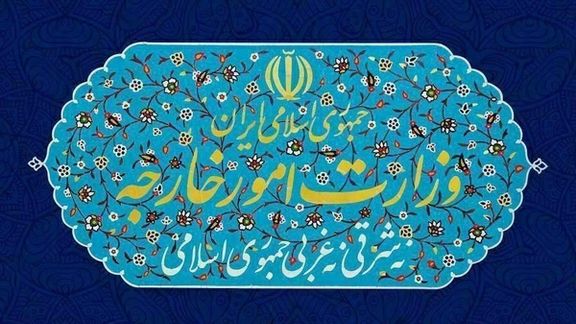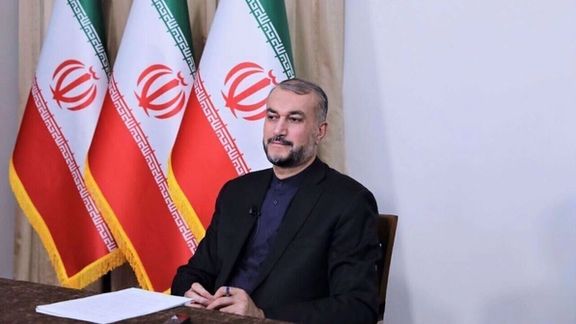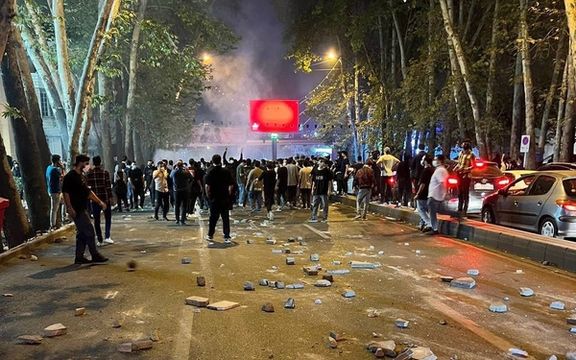‘Anonymous’ Releases Data Of All MPs, Urges Iranians Not To Stop ‘Revolution’

Hacktivist group ‘Anonymous’ has hacked the database of Iran’s parliament and the Supreme Audit Court, releasing the phone numbers and other data of all lawmakers.

Hacktivist group ‘Anonymous’ has hacked the database of Iran’s parliament and the Supreme Audit Court, releasing the phone numbers and other data of all lawmakers.
In a video message published on Sunday, the group announced it has hacked the website of the parliament as part of its ongoing operation against the government of Iran in solidarity with the popular protests triggered by the death in custody of the 22-year-old woman Mahsa Amini.
“Our support for the Iranian protests will continue. As you all know, the government is trying everything to stop you. Don’t give up,” said a distorted voice on the video. “Do not leave the streets. Do not stop the revolution.”
“The Iranian parliament supports the dictator when it should support the people, so we are releasing the personal information of all of them,” the group said.
On Saturday, the hacking collective took down the website of Iran's state-run Arabic news network Al-Alam, a few days after it attacked the official website of Iran’s Supreme Leader Ali Khamenei amid the nationwide protests in the country. Both the Persian and English versions of Khamenei’s website are still down.
A number of state-run websites in Iran, such as IRGC-affiliated Fars news agency and the news website of the state broadcaster have limited access to their pages from abroad over fears of being attacked by the hacktivist group.
If Iran government blocks the people from accessing the internet, Anonymous will block the government from accessing the internet, the group has said.

Iran's state-run television (IRIB) said Saturday evening that so far 41 have been killed in the protests and claimed that Tehran and other cities were “quiet”.
In its 20:30 special bulletin, the IRIB claimed that Tehran and many other cities had a “quiet night” while reports and footage on social media at the same hour indicated fierce protests confronted by security forces on the streets in the northern and western neighborhoods and suburbs of the capital.
Iran Human Rights (IHR) said Saturday at least 54 protesters had been killed by then. In many cases, handing over the bodies of the victims to their families was made contingent on agreeing to secret burials, IHR reported.
Protesters blocked roads, set fire to trash cans, and chanted slogans against the regime and the Supreme Leader Ali Khamenei who in his only public appearance Wednesday made no mention of the death of Mahsa Amini whose death in custody sparked the protests last Friday.
A video from Shiraz has captured the moment when an anti-riot police officer violently shoving a young woman and hit her head on the curb. Another video from Shiraz showing a young woman standing on a car with her hair falling on her shoulders and waving her headscarf leading the other protesters’ chanting “Down with the Dictator” has gone viral on social media.
Internet and even phone lines have been completely cut off in Oshnavieh, a town of around 40,000 in northwestern West Azarbaijan Province, where protesters drove the Revolutionary Guards (IRGC) out of its barracks and seized three bases used by the Basij, a militia controlled by IRGC, taking control of the town, with Kurdish majority population, on Friday.
Very little is known about the situation in Oshnavieh, but informed sources told Iran international that military forces are surveilling the town and its surrounding villages with helicopters and drones while preparing to deploy to the area.
State media, officials, Friday prayer leaders, and pro establishment social media users in the past few days have tried to claim that protesters attack or torch ambulances and public transportation buses.
Protesters have published several videos showing security forces using these vehicles for getting close to the heart of the protests or transporting those they arrest such as a video from Mashhad that shows an ambulance driving into a police station.
They have also claimed that protesters have torched mosques, burned the Quran and set fire to a religious banner used in ceremonies to mourn Imam Hussain, a Shia saint.
Many protesters believe these were perpetrated by agents of the state to incite religious people. A popular former national football (soccer) team player, Ali Karimi, who lives in the UAE, has called on protesters not to attack banks, women clad in black veils, and respect the Quran.
“Don’t join in with anyone who does these things because these are some of the plots of [regime agents to discredit] you my dear people,” Karimi tweeted Thursday. Videos posted on social media show protesters chanting Karimi’s name.
Authorities have resorted to what global Internet watchdog NetBlocks has called “curfew-style cellular network disruptions” to interrupt contact among protesters and leaking of footage from the protests. they have also restricted Instagram, WhatsApp, LinkedIn, and Skype as well as some popular videogames such as Clash of Clans the chatrooms of which could be used for communication among protesters, at the national level.
Hacktivists sympathizing with protesters have also been at work targeting the websites of the government and its affiliates including the website of the ministry of foreign affairs.

Iran’s foreign ministry has summoned the British ambassador in Tehran over what it calls “a hostile atmosphere” created by London-based Persian media outlets.
The official website of Iran’s government IRNA reported on Sunday that Simon Shercliff was called in by the ministry on Saturday to convey Tehran’s protest to the UK government for hosting the media channels.
There are three London-based major Iranian satellite TV channels beaming programs into Iran; Iran International TV, Manoto TV and BBC Persian.
During the meeting, the British envoy was told that by hosting these media outlets, London is interfering in Iran’s affairs, and that Tehran considers this an action against the national sovereignty of our country.
The ministry said that in recent days the media channels have put “incitement of violence and spread of riots” on top of their agenda, referring to the nationwide unrest following the death of Mahsa Amini, the young woman who died in the hands of hijab enforcement police.
The Iranian Foreign Ministry also summoned the Norwegian ambassador over “meddlesome” remarks by the Parliament President, Masud Gharahkhani, an Iranian-Norwegian in support of and solidarity with Iran’s protests, saying his "prejudgment” about the unrest is “wrong” and “unconstructive”.
Numerous protest rallies also have taken place outside the Islamic Republic’s embassies and consulates in cities around the world.
On Saturday night, two motorcycle-riding men threw a bottle of Molotov cocktail at the building of Iran’s embassy in the Greek capital Athens.

Iran’s Foreign Minister Hossein Amir-Abdollahian says the Americans have sent Iran a message “in recent days” expressing their resolve to reach a deal in good faith.
“We told them to realistically translate their words into action so that we can reach a deal,” he said on Saturday, referring to a final agreement on the revival of the 2015 Iran nuclear deal, officially known as the Joint Comprehensive Plan of Action (JCPOA).
Amir-Abdollahian, who is still in New York holding meetings on the sidelines of the 77th UN General Assembly session, highlighted that he has made it clear to representatives of the European Union and signatories to the JCPOA that Iran possesses the required will and determination to reach an agreement.
“It is now the American side that must have the courage to take a decision in order for us to talk about striking a good, strong, and durable agreement,” the Iranian foreign minister pointed out.
Since the start of the popular protests in Iran over the death of 22-year-old Mahsa Amini in custody of hijab police, the prospect of restoring the deal seems even dimmer.
US Special Envoy for Iran Robert Malley said Saturday, “While Iran’s government brutalizes peaceful demonstrators and tries to choke off Iranians’ access to the global internet, the United States is taking action to help the Iranian people communicate with one another.”
Iran's Foreign Ministry spokesman said earlier in the day that the US Treasury's move to issue a General License to boost support for internet freedom in Iran is an effort to "violate Iran's sovereignty" and will not remain unanswered.

The Islamic Republic's tactic to deal with any major unrest has been firing at protesters, arresting activists, then staging a rally to show it has legitimacy.
The government did the same during the protest that followed the death in custody of a young woman which enraged large groups of Iranians including, most noticeably, women and youths. The regime used force and then tried to put up a show of force, which was the rally on Friday along a half-a-mile route turned out to be a fiasco.
Even the news program on Channel 3 of the state television on Friday was not convinced that the lacklustre rally was a definitive answer to more than a week of protests in Tehran and over 80 other cities. As Abolfazl Najafi Tehrani, an Iranian cleric wrote on Twitter on Saturday, the government is likely to lure and bus demonstrators from small towns around Tehran for yet another "definitive" show of support on Sunday.
In another odd event, the Channel 3 evening news, showed nearly all the user-generated videos of protests that had been aired by foreign-based satellite televisions beaming into Iran, but at the end of every clip it pointed out that protesters insulted the regime’s values, which was true, as demonstrators have made it clear that they do not want the Islamic Republic and clerical rule.
During the past 43 years, the Islamic Republic has done everything possible to impose its "values" on Iranians. However, the presence of tens of thousands of Iranians born after 2000 in the protests revealed that state propaganda has not been successful. Protesters showed to politicians that the teachings of the Islamic Republic are different from those of Islam. They grew up to know the Islamic Republic through major financial corruption cases, inefficient economic and foreign policy, and coercive domestic politics.
A large gathering in front of the notorious Evin prison on Saturday, the beginning of the week in Iran, of individuals looking for their "disappeared" family members, revealed the extent of the government's violence against protesters during the past week. There are long lists of those who have disappeared in recent days on various social media platforms.
Nonetheless, the protests continue with an ever-increasing momentum in the streets of Iran. The government specially cannot believe the large scope and severity of the protests in the religious cities of Qom and Mashad, where protesters fiercely "disciplined" the security forces. Cities such as Rasht, Qazvin, and Tehran have been the scenes of massive anti-government rallies particularly on Friday night.
The continued confrontation after the Islamic Republic's staged-managed rally of its supporters, show the government and protesters, are still testing each other's determination. According to reports, government forces killed at least 35 protesters until Friday. But the actual casualty toll is obviously much higher, as it has always been. In 2019, it took several weeks after the end of the protests for the media to realize that at least 1,500 protesters were shot dead. However, this round of protests still continue with slogans getting increasingly serious. What they chant in the streets is no longer about hijab or the heavy-handed morality police. Based on what they do and say, they want nothing less than a regime change. Whether this is feasible or not, will, among other things, depend on the government and the protesters' determination and their ability and logistics to continue the confrontation.

Iran's exiled Prince Reza Pahlavi has called on Iran’s security forces to join the people and stand against the Islamic Republic’s repression machine.
In an exclusive interview with Iran International on Saturday Pahlavi said, "The army is the guardian of the country and the border, but today there is a situation where the internal enemy is shooting at the people... the military forces should be a shield for the defenseless people."
The exiled prince added that people will accept the security forces, noting that "People say that we do not intend to take revenge and we will accept you, but you should join us and not defend the system."
Iran's traditional army (Artesh) has been kept in a weak position by the Islamic Republic and is controlled by officiers from the revolutionary Guard (IRGC). Still, many hope that one day the army might come to the defense of protesters and stop the IRGC and other regime forces from using military and brutal force against the people.
Pahlavi also said that one of the measures needed to organize protests is to present a united front and select a leader for the opposition to interact with other countries.
The world must know what the alternative for the Islamic Republic is, he said, noting that political forces should cooperate beyond the streets.
"We may have different political inclinations in Iran tomorrow, but at this stage we have a common goal to save the country," he added.
Pahlavi held a meeting with a delegation from the European Parliament regarding the ongoing protests in Iran, urging European leaders to support the Iranians who are out on the streets for their demands.
In a tweet earlier in the day, he urged European countries to recall their ambassadors from Tehran.
Many demonstrators during a series of protests since 2017 have chanted slogans in support of the Pahlavi kings, seeing the 20th century dynasty as the force that modernized Iran, with building educational, industrial, military, legal and other infrastructure needed for development. However, Reza Pahlavi has said he is not aspiring to restore monarchy and the people should decide what form of government they prefer once the Islamic Republic is overthrown.
At the same time, voices among Iranians say that the current protests need a leadership and an alternative government to the clerical regime.
The latest round of nationwide protests in Iran appears to be different from the protests that have rocked the Islamic Republic since 2017.
The protests that started in Tehran on September 16 followed the death in custody of Mahsa Amini, 22, and not triggered by financial hardships Iranians have been experiencing in recent years.
The aim of most protesters, however, appears to be regime change and full freedom, not just partial concessions by the government.